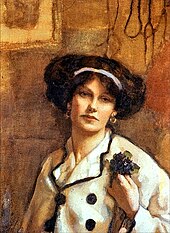Norah Neilson Gray
Norah Neilson Gray (born June 16, 1882 in Helensburgh , Argyll and Bute , † May 27, 1931 in Glasgow ) was an important Scottish portrait painter and an important representative of the Glasgow School .
Life
Norah Neilson Gray was born in Helensburgh in 1882 as the daughter of a ship owner. In 1901 she moved with her family to Glasgow and studied at the Glasgow School of Art from 1901 to 1906 . She later taught painting and design at St. Columba's School in Kilmacolm , Inverclyde . In 1910 she set up her own studio on Bath Street in Glasgow. After she had submitted some works to the Royal Academy of Arts , the Royal Glasgow Institute of the Fine Arts and the Paris Salon and thereby gained a certain prominence, she gave her first solo exhibition in Glasgow. During the First World War she worked as a nurse in France. After her return to Glasgow she continued her work as an artist and was mainly active in portraiture. In 1921 she was appointed by the Royal Glasgow Institute of the Fine Arts as the first woman to be appointed to the Hanging Committee , which selects the paintings for the annual exhibitions. At the end of the 1920s, Norah Neilson Gray fell ill with cancer , but this did not prevent her from continuing to paint until she died in 1931 and exhibiting regularly in Scotland, London and Paris.
plant
Norah Neilson Gray was considered one of Britain's leading painters in the early 20th century and was part of the Glasgow Girls , a group of young artists including Frances MacDonald McNair , Margaret MacDonald Mackintosh and Bessie MacNicol , who had all graduated from the Glasgow School of Art and now significantly shaped the art scene in Glasgow. Like the MacDonalds sisters, Gray painted with watercolors , but was particularly successful with her portraits in oil paint . The preferred motifs were initially young women and children. Influenced by experiences in the First World War, she later dared to make realistic representations. So is The Belgian Refugee from 1915 a man from Liege , who had fled to Scotland when Belgium at the beginning of the war of Germany was conquered. The painting is regarded as one of Gray's strongest portraits and received a bronze medal at the exhibition in Paris in 1921, where it was highly regarded in art circles. Her early death was seen as a great loss to Scottish art, but like other artists of the time, she was almost forgotten a few decades later.
literature
- Jude Burkhauser: Glasgow Girls: Women in Art and Design 1880-1920 , Canongate Books 2001, ISBN 978-1841951515
Web links
| personal data | |
|---|---|
| SURNAME | Neilson Gray, Norah |
| ALTERNATIVE NAMES | Neilson, Norah |
| BRIEF DESCRIPTION | Scottish painter |
| DATE OF BIRTH | June 16, 1882 |
| PLACE OF BIRTH | Helensburgh , Argyll and Bute , Scotland |
| DATE OF DEATH | May 27, 1931 |
| Place of death | Glasgow , Scotland |


